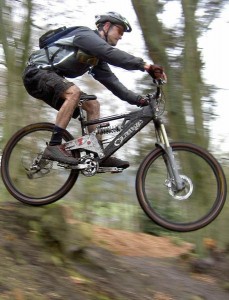Pedal Power
Posted on November 10th, 2011 by Andries Lodder
By Andrew Savvides, Qualified Physiotherapist
 With summer on our doorstep and days getting longer and warmer, many people are taking to the outdoors to find their fitness fix. And, what better way to enjoy this country’s spectacular natural areas and climate than through mountain biking or cycling. Many have set the annual 94.7 Cycle Challenge as their goal, and with the event around the corner beginners and experienced cyclists alike have been taking to streets and off-road trails in preparation.
With summer on our doorstep and days getting longer and warmer, many people are taking to the outdoors to find their fitness fix. And, what better way to enjoy this country’s spectacular natural areas and climate than through mountain biking or cycling. Many have set the annual 94.7 Cycle Challenge as their goal, and with the event around the corner beginners and experienced cyclists alike have been taking to streets and off-road trails in preparation.
Aside from knowing where the best spots are to enjoy a post-cycle breakfast, what else do cycling enthusiasts really need to know? Fitness and preparation for any sporting activity include understanding the associated risks – making this an opportune time to delve into common cycling injuries.
There will always be traumatic injuries that result from falls and other unplanned adverse events, the effect of which a physiotherapist will do their best to mitigate, to encourage healing. However what many physiotherapists deal with is the effect on the body of the repetitive motion and rhythm of cycling, which can cause what is called a repetitive strain injury due to incorrect biomechanics.
Common biomechanical faults:
- Forward head posture with craniovertebral extension (causing many cyclists to suffer neck pain)
- Thoracic kyphosis (the spinal curve being exaggerated due to the cycling position)
- Posterior pelvic tilt (the pelvis tilted backwards)
- Hip adduction and internal rotation (the hip turned inwards and across the body also due to the cycling position)
These postural problems can be minimized far in advance of commencing cycling by spending a little extra money on ensuring that a bicycle is set up correctly for an individual’s unique physiology – by a professional.
Something as simple as making sure your saddle is at the correct height and that your cleats are in the right position – and not rotated – can go a long way towards preventing much future discomfort and injury.
That said, the cycling position is not a natural one and following training in this position for extended periods of time many cyclists develop weakness of their hip extensors (which move hips backwards), their abductors (which move hips outward), lateral rotators (which turn the hips out to the side) and over activity of the hip flexors (which move hips forward), the adductors (which move hips inwards) and the medial rotators (which turn hips inward).
It is also very common for cyclists to have very tight calf muscles, which affects range of movement at the ankle making cyclists more prone to injury in that area. Remember to always stretch hip flexors, adductors, medial rotators as well as the calf muscles adequately before and after training.
It’s very important for cyclists to strengthen their hip extensors, abductors and lateral rotators. A very good way to do that is to start cross training i.e. exercising off the bike to target these muscle groups through other forms of exercise. It has also been shown that cyclists have a lower bone density -especially in the lumbar spine and hips – due to excessive calcium loss through sweating and all the hours spent on the bike. As cycling is a non-weight bearing activity it doesn’t promote an increase in bone density, but cross training – particularly doing weight-bearing exercises – will ensure bone density remains optimal.
Tweet